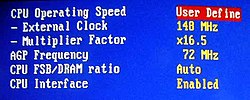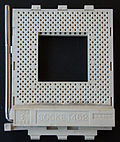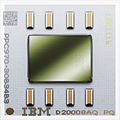The front-side bus (FSB) is a computer communication interface (bus) that was often used in Intel-chip-based computers during the 1990s and 2000s. The...
20 KB (1,820 words) - 09:40, 27 May 2025
back-side bus along with a front-side bus (FSB), the design is said to use a dual-bus architecture, or in Intel's terminology Dual Independent Bus (DIB)...
4 KB (404 words) - 15:33, 3 December 2023
NetBurst (section Quad-Pumped Front-Side Bus)
the Core 2. The Northwood and Willamette cores feature an external Front Side Bus (FSB) that runs at 100 MHz which transfers four bits per clock cycle...
16 KB (1,648 words) - 01:48, 3 January 2025
The Runway bus is a front-side bus developed by Hewlett-Packard for use by its PA-RISC microprocessor family. The Runway bus is a 64-bit wide, split transaction...
3 KB (411 words) - 06:15, 15 July 2023
Variants Pentium 955 EE – 3.46 GHz, 1066 MHz front-side bus Pentium 965 EE – 3.73 GHz, 1066 MHz front-side bus Nocona Introduced 2004 Irwindale Introduced...
199 KB (13,736 words) - 22:13, 25 May 2025
decoder Bus contention Bus error Bus mastering Communication endpoint Computer port (hardware) Control bus Crossbar switch Memory address Front-side bus (FSB)...
30 KB (3,859 words) - 18:04, 24 June 2025
HyperTransport (category Computer buses)
technology[clarification needed]—a wider range of RAM speeds on a common CPU bus than any Intel front-side bus. Intel technologies require each speed range of RAM to have...
21 KB (2,371 words) - 17:47, 2 November 2024
available in large quantities later in 1997. These CPUs had a 66 MHz front-side bus and were initially used on motherboards equipped with the aging Intel...
23 KB (2,519 words) - 08:08, 19 June 2025
clock and was accessed via its own 64-bit back-side bus, allowing the processor to service both front-side bus requests and cache accesses simultaneously...
49 KB (4,986 words) - 15:04, 13 June 2025
single local bus to the DIB, using the external front-side bus to the main system memory and I/O devices, and the internal back-side bus to the L2 CPU...
13 KB (1,648 words) - 08:39, 27 May 2025
run reliably at 450 MHz. This was achieved by simply increasing the front-side bus (FSB) clock rate from the stock 66 MHz to the 100 MHz clock of the Pentium...
56 KB (6,085 words) - 20:51, 28 March 2025
Pentium III "Coppermine" core. The "Cascades" Xeon used a 133 MT/s front side bus and relatively small 256 kB on-die L2 cache resulting in almost the...
115 KB (7,795 words) - 02:47, 19 June 2025
but sometimes to allow for underclocking in order to maintain the front side bus speed (on older CPUs) compatibility with certain motherboards. Unlocking...
48 KB (5,969 words) - 19:27, 22 March 2025
range is the last flagship range of Intel desktop processors to use a front-side bus (FSB). The introduction of Core 2 relegated the Pentium brand to the...
17 KB (1,159 words) - 18:43, 26 May 2025
between micro-chips, including DDR SDRAM, SGI XIO interface, Intel Front Side Bus for the x86 and Itanium processors, HyperTransport, SPI-4.2 and many...
5 KB (751 words) - 16:45, 20 July 2024
Slot A CPU interface used in some Athlon Thunderbird processors. The front-side bus frequencies supported for the AMD Athlon XP and Sempron are 133 MHz...
8 KB (729 words) - 01:05, 15 June 2025
original Duron was introduced with a 100 MHz (effectively 200 MHz) front-side bus – the same as the then current Socket A Athlons. Later with the introduction...
11 KB (1,219 words) - 17:04, 25 May 2025
CPU multiplier (redirect from Bus/core ratio)
clock of 3.6 GHz. The external address and data buses of the CPU (often collectively termed front side bus (FSB) in PC contexts) also use the external clock...
7 KB (890 words) - 11:28, 19 August 2024
945GM chipset, with Intel's GMA 950 integrated graphics on a 667 MHz front side bus. Later revisions of the MacBook moved to the 64-bit Core 2 Duo processor...
66 KB (4,060 words) - 18:31, 21 June 2025
Technology. Improved, higher bandwidth front side bus (FSB), with three times the capacity of the existing bus design. It is meant to be at system level...
6 KB (689 words) - 15:14, 6 August 2024
dies) in a multi-chip module clocked at CPU-speed Socket: Socket 8 Front-side bus: 60 and 66 MHz VCore: 3.1–3.3 V Fabrication: 0.50 μm or 0.35 BiCMOS...
35 KB (4,271 words) - 22:06, 25 June 2025
Intel Dynamic Front Side Bus Frequency Switching: Supported by E1, G0, G2, M0 Steppings Socket P processors can throttle the front-side bus (FSB) anywhere...
497 KB (14,119 words) - 13:19, 19 June 2025
impact of higher power consumption on the deeper pipeline design. A front-side bus using a variant of Gunning transceiver logic to enable four discrete...
15 KB (1,545 words) - 12:50, 24 June 2025
100 MHz front side bus, Pentium II CPUs were able to scale better in performance by reducing the difference between processor clock and bus speed. The...
7 KB (906 words) - 22:26, 24 May 2022
PowerPC 970 (section Buses)
512 KB of full-speed L2 cache and clock speeds from 1.6 to 2.0 GHz. The front side bus runs at half the processor's clock speed. The PowerPC 970FX has a 90 nm...
16 KB (1,699 words) - 20:22, 25 August 2024
III–branded CPU by adding the front-side bus (FSB) interface of Pentium 4, an improved instruction decoding and issuing front end, improved branch prediction...
16 KB (1,759 words) - 08:29, 1 June 2025
L2 cache shared by both cores, and an arbiter bus that controls both L2 cache and FSB (front-side bus) access. The successor to Core is the mobile version...
276 KB (9,895 words) - 17:34, 2 June 2025
33 MHz (33×3), and 50 MHz (50×2) front side bus 100 MHz capable edition for 33 MHz (33×3), and 25 MHz (25×4) front side bus 120/133 MHz capable edition for...
9 KB (984 words) - 23:46, 2 November 2024
communicate with each other at data rates expected of the traditional front-side bus (FSB) technology running from 400 MT/s to 1600 MT/s, while maintaining...
4 KB (510 words) - 17:16, 8 June 2024
trademark. The front panel switched from a blueberry color to gray (initially in a shade Apple called "graphite"), the formerly frosted white side panels became...
34 KB (2,058 words) - 13:54, 17 June 2025





















